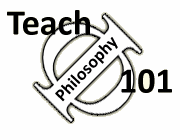Teach Philosophy 101
Free resources for
philosophy teachers!
"One of the most comprehensive, well-researched, and accessible guides for teachers that I have ever seen." James Lang, Chronicle of Higher Education (read full review of TΦ101)
Giving Effective Lectures
Though many instructors may rely too heavily on lecturing as a technique, lectures have a valid place in intro courses. In Teaching Philosophy, Brook Sadler outlines some of the specific advantages of lectures in intro philosophy classes.
Advantages of Lectures:
-
Communicating interest in the subject. A good lecture can make something more exciting than even the best written book or most lively video.
-
Conveying information not easily available in any other source.
-
Structuring information to suit the purposes of the course and the instructor.
Disadvantages of Lectures:
-
Students (especially less mature students) tend to lose interest after a fairly short period of time.
-
Lectures can play into the "dualist" mentality of immature students, that learning is about getting accurate information from the instructor and being able to repeat it.
-
Conversely, lectures are not very effective in teaching critical thinking or higher order skills.
Techniques for Effective Lectures:
-
Reset students' attention every 15 minutes. Students have short attention spans, and according to some observers, 15 or 20 minutes is as long as one can expect. After fifteen minutes, it is useful to "reset" the attention by interjecting some activity by the students. This could be as simple as asking students to write a single sentence explaining the main point being discussed, or to explain something that they haven't understood (O'Connor). Barbara Millis has some interesting techniques for breaking up a lecture, including asking students NOT to take notes for a short period, then working in groups to reconstruct what they heard.
-
Intersperse group activities. For example, a twenty minute lecture, followed by a ten minute group discussion, followed by another twenty minute lecture can be much more effective than 50 minutes of straight lecture (Bonwell and Eison 13). The group work could be a simple exercise such as "think-pair-share" (see below) or a more complicated group activity.
-
Make lectures interactive. Find a way to solicit feedback from students during the lecture, for example, by asking for a show of hands "How many feel that . . . ?"
-
Use what the ed school types call "Classroom Assessment Techniques" (CATS) to break up lectures. The idea here is to use short, ungraded, anonymous student quizzes. These serve two purposes, providing you feedback and breaking up the lecture. Some faculty members use the "One Minute Paper" as a way to get feedback. In large lectures, some instructors use "clickers".
-
Use examples that relate material to everyday experience of students. Try not to rely entirely on "insider" examples. Students from different cultures and backgrounds may not respond to examples from sports, or areas of popular culture not familiar to them.
-
Help students organize their notes. The instructor can help students retain the material by providing a structure and emphasizing important points and connections.
-
Use visual aids. PowerPoint has its detractors (some people think it makes students passive and likely to fall asleep in a darkened rooms, but some studies show that it can be effective, especially if it can include graphics as well as bullet points (Clark).
-
Start with a problem that engages students. It is most effective to start with something that hooks students into the topic.
-
Use humor. Amazingly, some education researchers have studied classroom humor. Students respond best to humor about the course, gentle humor about students themselves, and good spirited self-depreciating humor about the professor. They don't like sarcastic or negative humor (according to an editorial in The Teaching Professor, 20.6 (2006) 1).
-
Learn to speak effectively. Have yourself videotaped and watch the video tapes with someone who can help you with public speaking tips.
Sources:
Bonwell, Charles C. and James A. Eison, Active Learning: Creating Excitement in the Classroom ASHE-Eric Higher Education Report No. 1. Washington, D.C.: The George Washington University, School for Education and Human Development, 1991.
Cashin, William E., "Improving Lectures," IDEA Paper No. 46, 2014.
Clark, Jennifer, "PowerPoint and Pedagogy." College Teaching. 56.1 (2008): 39-45.
Goulden, Nancy, "Improving Instructor's Speaking Skills," IDEA Paper No. 24, 1991, 24 January 2008
O'Connor, Terry (The College of New Jersey), The Complete Lecture, presentation at the Lilly East Conference: Learning by Design, University of Delaware, April 2008.
Sadler, Brook J., "How Important Is Student Participation in Teaching Philosophy?" Teaching Philosophy. 27.3 (2004): 266. Sadler argues that the value of lecturing (compared to class discussion) has been underestimated.
Detailed Material:
Think-Pair-Share: Stop the lecture, ask students to talk for a few minutes to one or two of the students sitting next to them, and generate either a question or a reaction to the material just being discussed. Don't ask for volunteers initially, but call on specific individuals to ask "What did your group come up with?"
One Minute Paper: Leave time in the end (or middle) of the lecture and ask students to take four or five minutes to write a short paper, saying what is the main point that they learned and what questions they still have. Some students report that knowing that they will be asked to do a one minute paper helps them organize their thoughts during the lecture, and the responses give the teacher a sense of what has been learned. See here for examples.
Author: John Immerwahr
Update: September 27, 2015 (E Tarver); July 2019
